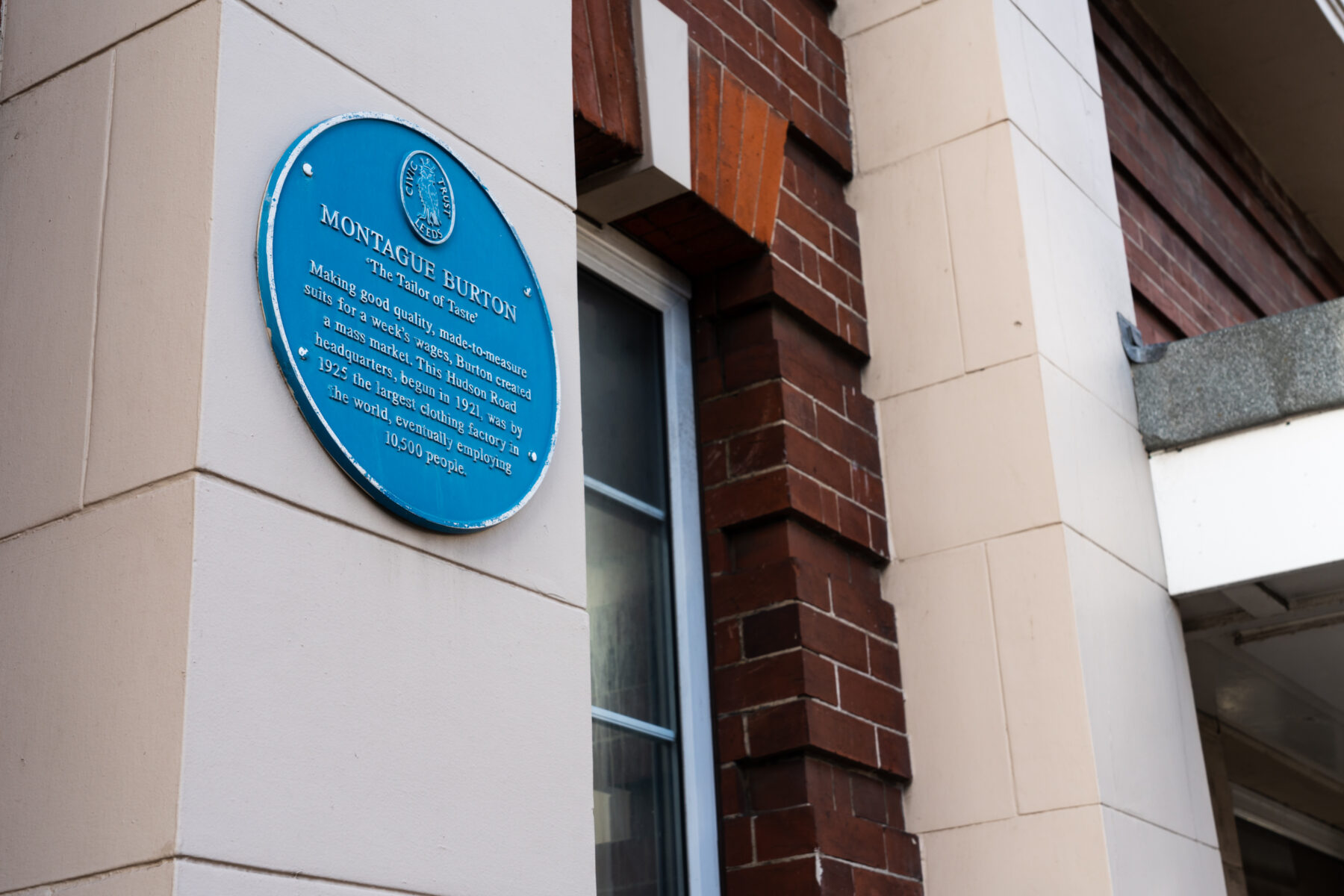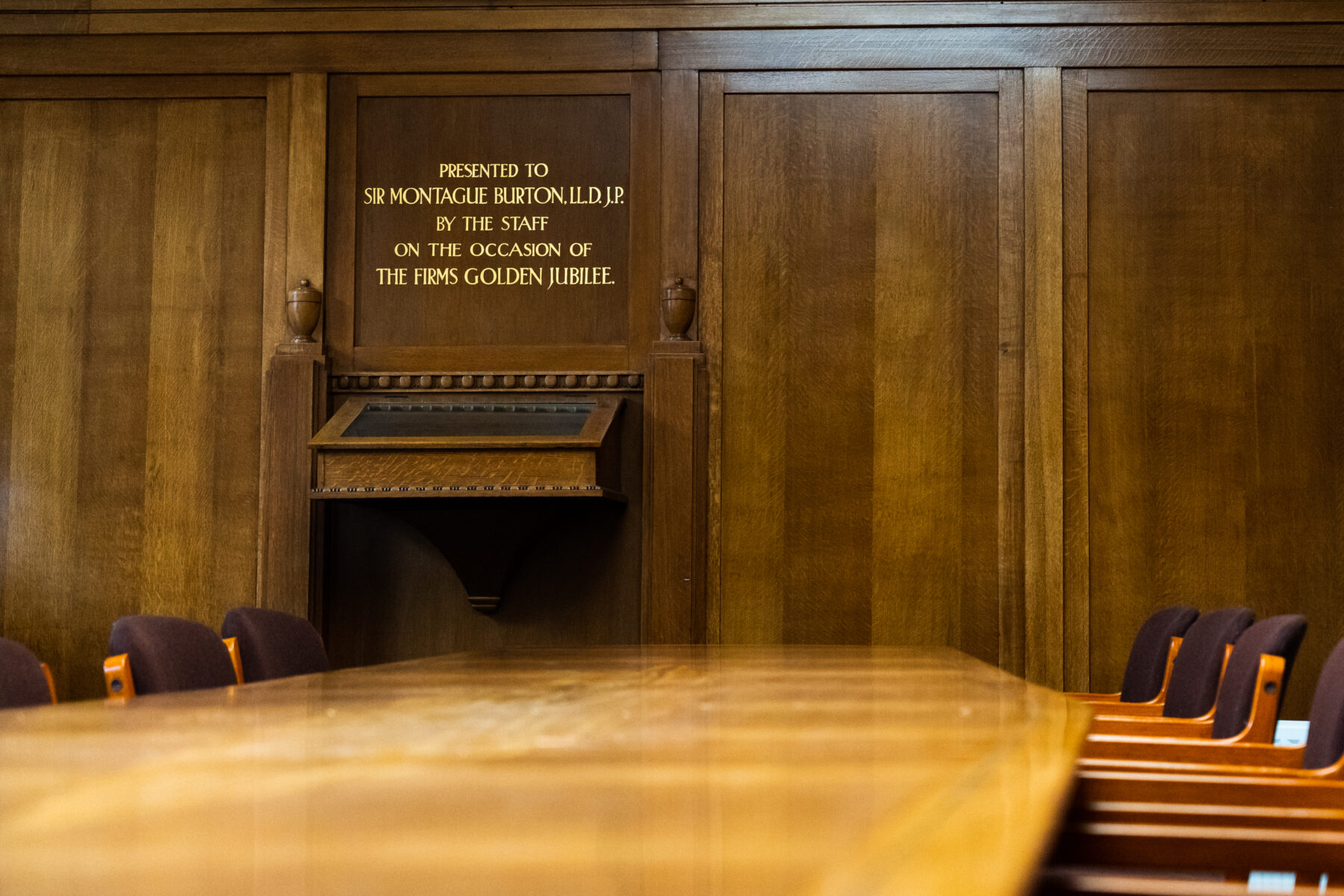
Article
Tailor-Made: Burton Factory
Chapter 81
Burton’s business park has had many incarnations over the years. Once a hub of industry for the people of east Leeds, it remains a cornerstone in the history of the Leeds industrial heritage.
The Burton Business Park site in Leeds has been in operation since 1922, most recently distributing stock for the Arcadia group stores including Dorothy Perkins and Burton.
In 1967 Arcadia became the new corporate title for the House of Burton. In 2002 Philip Green bought the Arcadia Group and became the first sole owner since Sir Montague himself.
Despite Boohoo’s purchase of the Burton brand, the Leeds facility went into administration and closed in 2021.

The site, on Hudson Road, just off Harehills Lane in Burmantofts, used to be home to the biggest clothing factory in the world and was the heart of Sir Montague Burton’s menswear empire.
“Good clothes develop a man’s self respect”, was one of Burton’s insights. He was dedicated to providing high-quality made-to-measure suits at a reasonable price. He revolutionised the industry with his promise of “a five-guinea suit for 55 shillings”
Sir Montague Burton had a vision: to make tailored made-to-measure suits at everyday prices.
In the 1920s, West Yorkshire was the textile manufacturing heartland of the UK. Leeds was men’s clothing; Bradford was wool; Halifax was carpets; Huddersfield was high quality cloth and engineering, especially for textile machinery; and Batley and Dewsbury were for shoddy – the recycling of rags.
The Hudson Rd site was chosen because it had the best of the best when it came to skilled tailors and machinists. Burton was the biggest employer in Leeds. At its height, around 10,000 people worked on the site, producing over 30,000 suits a week.
Men started work at 14 as barrow boys and would then be apprenticed as tailors and cutters. But they were outnumbered by women. There were vast workrooms of machinists with whole families working on the same production line. A former tailor for Burton’s once described it as “a town in itself”. The factory site had its own bus stop on the grounds. Workers were bused in from the then more rural areas such as Gipton and Cross Flats.
The Tailor of Taste
Learning Partnerships is a community based charity who have been based at the old Burton site for 30 years. Arriving at the entrance on Hudson Rd you can see an English Heritage blue plaque which reads, “MONTAGUE BURTON. ‘The Tailor of Taste’. Making good quality, made-to-measure suits for a week’s wages, Burton created a mass market. This Hudson Rd headquarters, begun in 1921, was by 1925 the largest clothing factory in the world, eventually employing 10,500 people.”

We spoke with ex Lord Mayor of Leeds and Chairman of Trustees Tom Murray, who gave us a tour and told us a little about the history of the site.
“Montague Burton was a first class entrepreneur. He arrived in England in 1900, at the age of 15. At age 18, he borrowed £100 to get set up in business. 20 years later, he’s making suits to order in 40 retail shops. By the time he was finished, he had 600 stores. You could say he was also a property developer due to the location of sites he purchased that are now prime retail locations.”
Tom showed us around the site including Sir Montague Burton’s original office, the boardroom and the old factory floor. To the side of the grand meeting table are photographs taken of past visitors to the factory including the then 10th Prime Minister of Australia, Joseph Lyons.

Much of the office space on the first floor hasn’t changed for over 50 years from Sir Montague’s leather topped desk to the carved wooden panelling and the mirrored alcoves in the room. We saw typed meeting minutes from 1964, hand drawn floor plans and an old promotion film reel titled ‘ The Road to Fashion’. There was even an autographed photograph of Old Hollywood star James Cagney with a dedication that reads, “To Lady and Sir Montague Burton, with pleasant memories and a most delightful cruise!”

Between the offices and the factory floor, Burton had a small private garden. Overgrown and unattended when we saw it, this would have been a little oasis in its time. A quiet, green space to escape to, tucked away from the noise and the heat of the factory surrounding it. The view from the first floor overlooks the factory below and in the distance stretches across Leeds from Elland Rd in the SouthEast to the Leeds University Parkinson building in the North of the city.
The attention to detail across the site remains evident. Art deco style iron work covers the doors to the old canteen building and the Burton insignia can even be seen on the drain pipes.

The Torre Rd side of the 40 acre site will soon be developed into housing, becoming Leeds’ largest brownfield site redevelopment project, with over 1 million sq ft of building space. Although overall a mixed use project, the majority of the land will be redeveloped by Avant Homes.
The Hudson Rd side of the site will remain undeveloped for a few years yet, and the full extent of plans for it remain unknown. This comes as good news for the Harehills community as it gives Learning Partnerships a home there for at least a few years. The charity runs a number of projects for local residents including ESOL classes, community links, stronger families and employability courses. Tom Murray commented, “There is a need, particularly for the people in this community to have space that they can use. We hope that some of it can be retained for community use in the future.”
An enlightened employer
Burton was known for going the extra mile to keep his staff happy; providing recreation facilities, health and pension schemes, free dentists and even chiropodists. Unheard of at the time in a pre-welfare Britain, Burton was an enlightened employer. He was aware of the demands that factory conditions had on the workers. Fainting and overheating were common so there was a nurse’s station on site. Eye specialists were available to treat eye strain brought on by close needlework.
Burton understood the importance of looking after his staff. At the time, the canteen was the largest in the world and could cater for 8000 workers in one sitting. If people arrived before 8am they would receive a free cup of tea or coffee. Staff morale and community were supported through recreation facilities such as bowling green, cricket pitch, and a gymnasium. There was a women’s cricket team that played regularly. One of the photographs from the boardroom was taken in 1934 when the men’s Australian cricket team paid a visit and we can only assume, played a game with the staff.

One thing that his employees looked forward to every year were Burton’s legendary Christmas parties. It was well known that every single child from his thousands of employees would come away with a present.
Welcome to Leeds spoke with a Harehills resident Eileen who worked at Burton as machinist in the fifties where she met her husband, Gerry. There was an option for women workers to put money away each month from their pay packet as part of a ‘dowry fund’. When they got married and had to stop working (as was the norm in 50s Britain), the company would match the money saved so that a couple could get set up. When Eileen left Burton’s in 1956, she had a dowry of £100, enough money for a deposit on a house. She and her husband Gerry lived off Harehills Lane for 20 years and have remained in the area since.
Burton became a household name because of good public relations and the way it treated its workers. In 1934 Sir Montague was congratulated by the Princess Royal for his magnificent achievement in creating a pioneering welfare system for his workers. On the eve of WW2, Burton again turned to the production of uniforms for troops. After the war, Burton produced a suit for war veterans nicknamed “The Full Monty”. By the end of the war, Burton had clothed around a fifth of British males. At the time of his death the company had become the largest multiple tailor in the world with 616 stores. In 1966 the Burton legacy lived on, suiting the England World Cup winners.
There is so much of Leeds history in that space, it’s fascinating to see. It makes one wonder how much more remains undiscovered. There must be many stories to tell. Do you have any memories of The Burton Factory? We’d love to hear from you.






